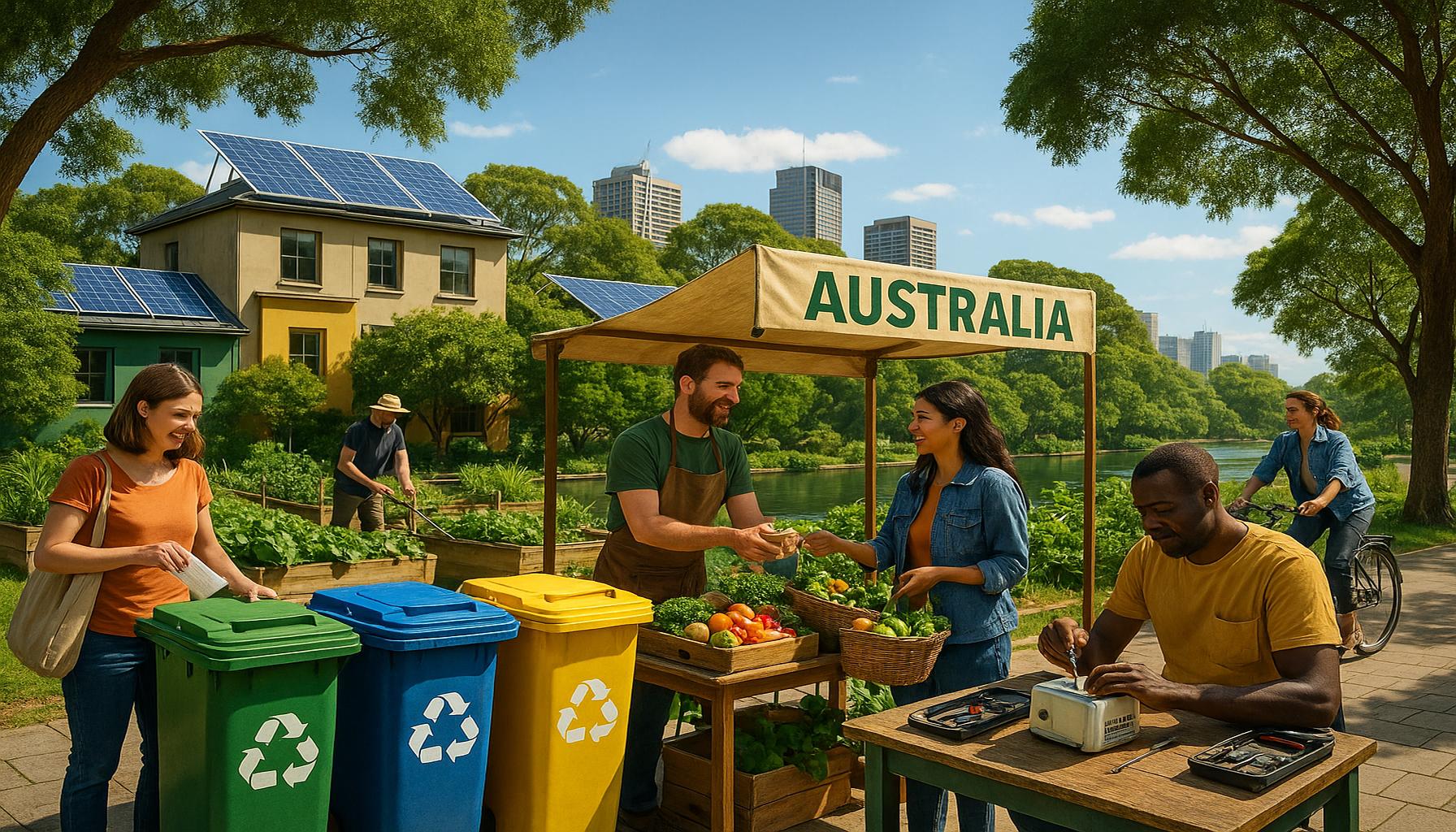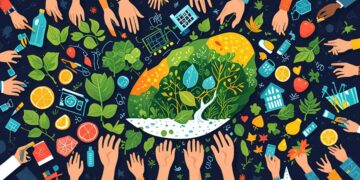The challenges and opportunities of the circular economy in Australia

Challenges in the Circular Economy Transition
The transition towards a circular economy in Australia is not without its difficulties. One of the most prominent challenges is the systemic transition required in shifting from traditional linear economic models, such as the prevalent “take-make-dispose” approach, to a more integrated circular system. This shift necessitates a change not only in how businesses operate but also in consumer behaviours. For instance, companies must rethink product design to prioritize longevity, repairability, and recyclability, while individuals need to embrace practices like recycling and purchasing second-hand goods more frequently. Educational initiatives aimed at raising awareness about the importance of sustainability and responsible consumption are crucial in this regard.
Another key obstacle is the infrastructure development needed to support a circular economy. Current waste management and recycling systems in Australia are often inefficient and ill-equipped to handle the requirements of a circular framework. This situation calls for significant investment in the development of advanced recycling facilities, efficient collection systems, and logistics networks that facilitate the recovery and recycling of materials. For example, initiatives like the National Waste Policy Action Plan are aimed at improving waste management practices across the country, but more substantial efforts are necessary to scale these advantages nationwide.
Additionally, regulatory barriers present a considerable challenge. The regulatory landscape in Australia can be intricate, leading to uncertainties that stifle innovation in sustainable practices. Businesses may find it difficult to navigate these regulatory requirements, which can hinder their ability to implement circular initiatives effectively. Simplifying and harmonizing regulations at both state and federal levels could pave the way for clearer pathways for businesses looking to adopt circular practices.
Opportunities within the Circular Economy Model
Despite the challenges, the potential economic growth associated with a circular economy is particularly compelling. Transitioning to this model could lead to the creation of new jobs in sectors such as recycling, remanufacturing, and sustainable product design. For example, a report by the Australian Council of Recycling suggests that a robust circular economy could generate over 8,000 jobs by 2025, providing a substantial boost to the Australian workforce.
Moreover, the shift to a circular economy fosters resource efficiency, allowing businesses to lower operational costs by maximizing the use of materials. Companies can capitalize on the cost savings gained through reduced raw material expenditure and improved waste management. The development of technologies such as advanced recycling systems and biodegradable materials can further enhance this efficiency.
Lastly, transitioning to circular models holds the potential for a significant positive environmental impact. By minimizing waste and promoting the reuse of materials, businesses can drastically reduce their carbon footprints and contribute to combating climate change. The move towards a circular economy aligns with global sustainability goals and positions Australia as a leader in environmental stewardship. As stakeholders begin to understand these dynamics, it becomes imperative for businesses, government, and communities to collectively embrace the circular economy as an essential framework for sustainable development in Australia.
CHECK OUT: Click here to explore more
Addressing the Complexities of Circular Economy Implementation
As Australia embarks on the journey towards a circular economy, it is vital to tackle the challenges that could impede this transition. One significant hurdle arises from the cultural shift required to embrace circular principles. Many industries and consumers have been entrenched in the linear economy mindset, where products follow a predictable path from production to disposal. Encouraging this cultural shift mandates not only altering purchasing habits but also reevaluating intrinsic values related to ownership, waste, and sustainability. For instance, businesses are prompted to rethink product lifespan, prioritizing durability and easy disassembly, while consumers must cultivate a mindset that values repaired and reconditioned products over new purchases.
Education and awareness play a pivotal role in facilitating this transition. Initiatives such as school programs focusing on environmental sustainability and community workshops promoting upcycling can drive home the significance of circular practices. By fostering a culture of sustainability, stakeholders are more likely to engage in activities such as responsible consumption, recycling, and sustainable disposal methods.
Another critical challenge involves financial investment in the necessary infrastructure. Australia’s current waste management systems are often inadequate for accomplishing the goals of a circular economy. Upgrading facilities to incorporate advanced sorting and recycling technology represents a significant financial commitment from both the public and private sectors. Some of the necessary infrastructure developments include:
- Modern recycling facilities capable of processing a broader range of materials.
- Improved collection systems that enhance the efficiency of recyclable waste retrieval.
- Logistics networks designed to facilitate the smooth transition of materials back into the manufacturing cycle.
The government can lead the way by investing in such infrastructure while also incentivizing private enterprises to follow suit through grants or tax breaks, creating a viable support system for circular practices.
Moreover, regulatory frameworks must adapt to accommodate the circular economy’s principles. The existing legislation often does not align with circular practices, making it cumbersome for businesses to innovate. For example, regulatory uncertainty surrounding recycling processes can deter companies from investing in sustainable technologies. Streamlining regulations and clearly defining circular economy standards can significantly enhance business confidence and facilitate faster implementation of circular practices across various sectors.
Ultimately, addressing these challenges offers a pathway not only for transformation but also for a stronger economic foothold. Australia stands at a crossroads, with the potential to emerge as a leader in the circular economy, provided that the identified barriers are effectively addressed through collaborative efforts among government, business, and the community.
SEE ALSO: Click here to read another article
Harnessing Opportunities for Growth and Innovation
While the transition to a circular economy presents multiple challenges, it also offers significant opportunities for growth and innovation. One of the most promising prospects lies in the development of new markets and business models that cater to a circular framework. For instance, the rise of product-as-a-service models enables companies to sell the utility of a product rather than the product itself. In this scenario, businesses retain ownership, leading to responsible product lifecycle management and encouraging the design of longer-lasting, easily repairable goods. This shift is already being witnessed in sectors like electronics and fashion, where companies such as Tesla and Nuuly utilize subscription models to optimize resource usage and reduce waste.
Furthermore, the resurgence of local manufacturing presents an opportunity for Australia to align with circular economy principles. By fostering local production capabilities, businesses can minimize transportation emissions and create a more resilient supply chain that relies on recycled materials, ultimately benefiting the local economy. Government initiatives, such as the National Recycling Strategy, aim to bolster domestic recycling capabilities and enhance local material recovery rates, ensuring alignment with circular economy objectives.
Another area ripe for opportunity is job creation associated with circular economy initiatives. Transitioning towards a circular economy will require new skill sets and roles, ranging from materials innovation to waste management. The Australian Bureau of Statistics reports suggest that industries focused on sustainability and recycling could potentially create hundreds of thousands of jobs over the next decade. By investing in training programs and educational initiatives tailored to the circular economy, Australia can equip its workforce with the necessary skills to thrive in this emerging market.
Collaboration among various stakeholders is crucial for capitalizing on these opportunities. Industry partnerships, public-private collaborations, and community engagement can lead to innovative solutions and facilitate knowledge sharing. For example, industry-led initiatives like the Australian Circular Economy Hub can foster collaborative projects that leverage shared resources and expertise. Such platforms can also bridge the gap between businesses and startups, bringing together diverse perspectives to tackle complex challenges and capitalize on circular economy opportunities.
Moreover, consumer preferences are progressively aligning towards sustainability, with a growing segment actively seeking eco-friendly products and brands that practice responsible production. According to a 2022 survey by Finder, nearly 70% of Australians expressed a preference for environmentally sustainable products. Businesses can leverage this consumer demand by innovating sustainable alternatives and adopting transparent practices that highlight their commitment to circularity. Emphasizing sustainability not only strengthens brand loyalty but also enhances competitiveness in an increasingly eco-conscious market.
As Australia progresses on the path toward a circular economy, the convergence of these opportunities signals a transformative shift in economic paradigms and societal values. By embracing innovative approaches, investing in education and local manufacturing, fostering collaboration, and responding to consumer demand, Australia is well-positioned to harness the full potential of a circular economy, paving the way for sustainable economic growth and environmental stewardship.
SEE ALSO: Click here to read another article
Conclusion
The journey towards a circular economy in Australia is both a challenge and an opportunity. As highlighted throughout this article, the challenges of transitioning to a circular model—including regulatory hurdles, infrastructure limitations, and market resistance—are significant. However, they provide a crucial impetus for innovation and adaptation within Australian industries. The potential for new business models, such as product-as-a-service schemes, presents avenues for sustainable growth that can transform consumer behavior and industry practices alike.
The alignment of government initiatives, like the National Recycling Strategy, with local manufacturing can catalyze a much-needed shift towards sustainability. Moreover, the forecasted job creation in sectors focusing on recycling and sustainability is critical, indicating a path towards economic resilience and a skilled workforce ready to tackle future challenges.
To fully capitalize on the advantages of a circular economy, it is essential that stakeholders collaborate effectively. Public-private partnerships and community engagement must become foundational elements in developing scalable, innovative solutions that benefit all sectors of society. Additionally, as consumer demand increasingly leans towards sustainable goods, businesses should prioritize transparent, eco-friendly practices to enhance their competitive edge.
In summary, Australia’s pursuit of a circular economy represents not just a necessity for environmental stewardship but a strategic opportunity for economic advancement. By embracing innovation, fostering collaboration, and responding to consumer desires for sustainability, Australia can pave the way for a resilient, circular economy that benefits generations to come.

Beatriz Johnson is a seasoned financial analyst and writer with a passion for simplifying the complexities of economics and finance. With over a decade of experience in the industry, she specializes in topics like personal finance, investment strategies, and global economic trends. Through her work, Beatriz empowers readers to make informed financial decisions and stay ahead in the ever-changing economic landscape.






